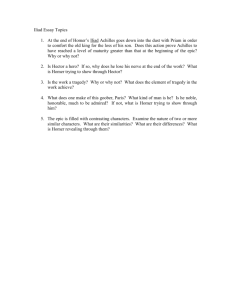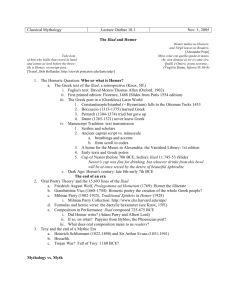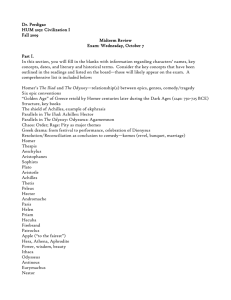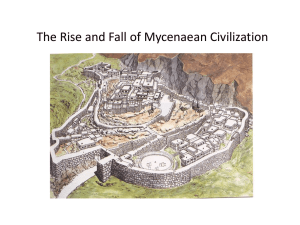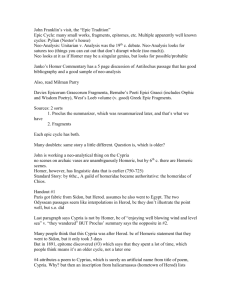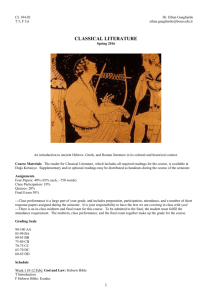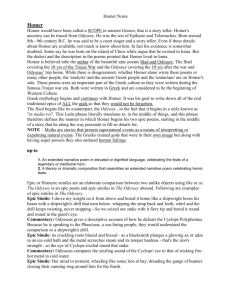Homer as History
advertisement
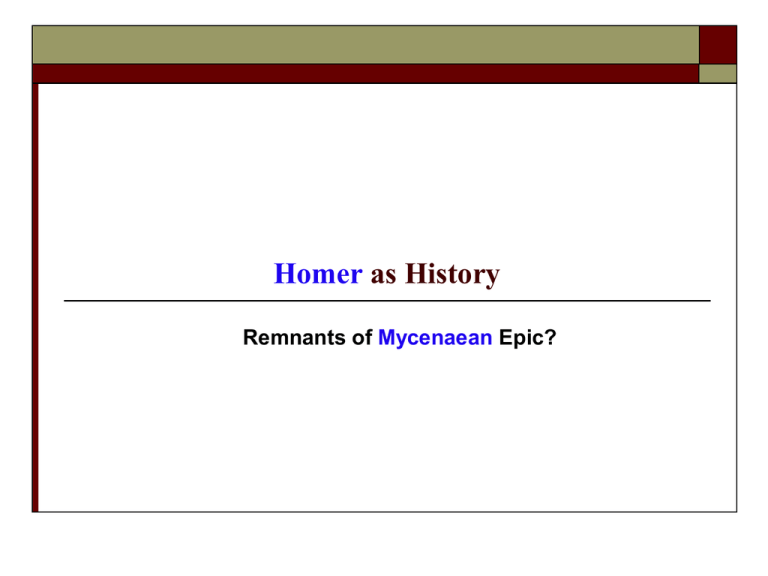
Homer as History Remnants of Mycenaean Epic? Periodization Dark Age: ca. 1200-ca. 750 BCE Sub-Mycenaean: ca. 1125-1050 BCE Protogeometric: ca. 1050-900 BCE Geometric Greece: ca. 900-700 BCE (Homeric Epics, Iliad and Odyssey) Archaic Period: ca. 750-ca. 480 BCE Sub-Mycenaean Vase Kerameikos Cemetery (Athens) Dark Age and Geometric Greece Post-Mycenaean World (1050-700 BCE) Palace Centers Destroyed (ca. 1200-1150 BCE) Colonization of Asia Minor Coast Crete (cf. Odyssey, 19.172-3; Cyprus) Rudimentary Material Culture on Mainland non-literate society based on villages approximate 75% population decline (?) disruption of trade, disappearance of imports Post-Mycenaean Movements Language Map of Post-Mycenaean World Discontinuities with Mycenaean Past Cremation instead of Inhumation Introduction of Iron-Working (from Cyprus) Emergence of Athens (embarkation point for colonizers; leader in proto-geometric pottery ca. 1050900 BCE; continuity of habitation (?); continuous series of graves in Kerameikos from sub-Mycenaean times) Disappearance of Literacy: Iliad 6.168: “baleful signs” (semata lugra) Oral Poetic Tradition and Dactylic Hexameter Homer, Iliad 6.168 To slay him he withheld, for his soul had awe of that; but he sent him to Lycia, and gave him baneful tokens, engraving in a folded tablet many signs and deadly, and bade him show these to his own wife's father, that he might be slain. Troy and Asia Minor Troy 2004 Geometric panel Trojan Horse Geometric Amphora Homeric Poems and Geometric Folk Memory of Bronze Age Greece Iliad and Odyssey: conservative nature of oral epic poetry Discovery: Milman Parry and Serbo-Croatian epic Reappearance of Writing in Greece ca. 800-750 BCE: Homeric epic and a society in transition Mycenaean Survivals in Homer King is wanax, not basileus King is chief judge, priest, and warlord Place names of no importance in Geometric period (Iliad 2, “Catalogue of Ships”) Palace-controlled society Dark Age Migrations Homeric World Anachronisms: Homeric World as Composite World Spear is thrown in Homer; Myceneans used thrusting spear Crete an Achaean island in Homer Cremation in Homer; no mention of tholos tombs Homer has no knowledge of palace bureaucracies (Linear B) Iron used for tools and implements; importance of Boeotia Who Was Homer? Does It Matter? Historical Personage?: “Homer was a man’s name, not the Greek equivalent of “Anonymous”, and that is the one certain fact about him” ~ M.I. Finley, World of Odysseus, 15 Circularity of the Biographical Tradition (Lefkowitz); Homer=“he who weaves together”? (Vermeule) Representation of Homer Homeric Influences: Homeric Ethics and the Competitive Excellences of the Warrior (Aristoi) Akhilleus as Model: Individual over Community? Glorification of War? Aristocratic Privilege (cf. Thersites at Iliad 2.211-77) Status and the Gift (Briseis in Iliad 1): zero-sum competition Apthniton Kleos; Arete Homer’s Authority: Thucydides on Trojan War (1.9-11) Athenian/Megarian War, ca. 600 BCE (Plutarch, Solon, 10) Thucydides, 1.9.4 The strength of his navy is shown by the fact that his own was the largest contingent, and that of the Arcadians was furnished by him; this at least is what Homer says, if his testimony is deemed sufficient. Besides, in his account of the transmission of the scepter, he calls him Of many an isle, and of all Argos king. [Homer, Iliad 2.108] Now Agamemnon's was a continental power; and he could not have been master of any except the adjacent islands (and these would not be many), but through the possession of a fleet. Plutarch, Solon 10.1 Notwithstanding all this, the Megarians persisted in their opposition, and both sides inflicted and suffered many injuries in the war, so that finally they made the Spartans arbiters and judges of the strife. Accordingly, most writers say that the fame of Homer favored the contention of Solon; for after himself inserting a verse into the Catalogue of Ships, he read the passage at the trial thus:-Ajax from Salamis brought twelve ships, And bringing, stationed them near the Athenian hosts.
